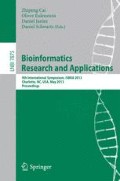Abstract
Conformation alignment is a critical step for properly interpreting protein motions and conformational changes. The most widely used approach for superposing two conformations is by minimizing their root mean square distance (RMSD). In this work, we treat the alignment problem from a novel energy-minimization perspective. To this end we associate each atom in the protein with a mean-field potential well, whose shape, ellipsoidal in general, is to be inferred from the observed or computed fluctuations of that atom around its mean position. The scales and directions of the fluctuations can be obtained experimentally from anisotropic B-factors for crystal structures or computationally. We then show that this “ellipsoid-weighted” RMSD alignment can be reformulated nicely as a point-to-plane matching problem studied in computational geometry. This new alignment method is a generalization of standard RMSD and Gaussian-weighted RMSD alignment. It is heavily weighted by immobile regions and immobile directions of the protein and hence highlights the directional motions of the flexible parts. It has an additional advantage of aligning conformations of proteins along their preferred directions of motions and could be applied to order protein conformations along its trajectory.
Access this chapter
Tax calculation will be finalised at checkout
Purchases are for personal use only
Preview
Unable to display preview. Download preview PDF.
References
Karplus, M., McCammon, J.A.: Molecular dynamics simulations of biomolecules. Nat. Struct. Biol. 9, 646–652 (2002)
Tama, F., Sanejouand, Y.H.: Conformational change of proteins arising from normal mode calculations. Protein Eng. 14, 1–6 (2001)
Atilgan, A.R., Durell, S.R., Jernigan, R.L., Demirel, M.C., Keskin, O., Bahar, I.: Anisotropy of fluctuation dynamics of proteins with an elastic network model. Biophys J. 80, 505–515 (2001)
Song, G., Jernigan, R.L.: An enhanced elastic network model to represent the motions of domain-swapped proteins. Proteins 63, 197–209 (2006)
Henzler-Wildman, K., Kern, D.: Dynamic personalities of proteins. Nature 450, 964–972 (2007)
Dror, R.O., Dirks, R.M., Grossman, J.P., Xu, H., Shaw, D.E.: Biomolecular simulation: a computational microscope for molecular biology. Annu. Rev. Biophys 41, 429–452 (2012)
Kabsch, W.: Solution for Best Rotation to Relate 2 Sets of Vectors. Acta Crystallogr. A 32, 922–923 (1976)
Mclachlan, A.D.: Rapid Comparison of Protein Structures. Acta Crystallogr. A 38, 871–873 (1982)
Kabsch, W.: Discussion of Solution for Best Rotation to Relate 2 Sets of Vectors. Acta Crystallogr. A 34, 827–828 (1978)
Coutsias, E.A., Seok, C., Dill, K.A.: Using quaternions to calculate RMSD. J. Comput. Chem. 25, 1849–1857 (2004)
Khazanov, N.A., Damm-Ganamet, K.L., Quang, D.X., Carlson, H.A.: Overcoming sequence misalignments with weighted structural superposition. Proteins 80, 2523–2535 (2012)
Wriggers, W., Schulten, K.: Protein domain movements: Detection of rigid domains and visualization of hinges in comparisons of atomic coordinates. Proteins-Structure Function and Genetics 29, 1–14 (1997)
Irving, J.A., Whisstock, J.C., Lesk, A.M.: Protein structural alignments and functional genomics. Proteins 42, 378–382 (2001)
Damm, K.L., Carlson, H.A.: Gaussian-weighted RMSD superposition of proteins: A structural comparison for flexible proteins and predicted protein structures. Biophysical Journal 90, 4558–4573 (2006)
Theobald, D.L., Wuttke, D.S.: Empirical Bayes hierarchical models for regularizing maximum likelihood estimation in the matrix Gaussian Procrustes problem. Proc. Natl. Acad. Sci. U S A 103, 18521–18527 (2006)
Theobald, D.L., Wuttke, D.S.: THESEUS: maximum likelihood superpositioning and analysis of macromolecular structures. Bioinformatics 22, 2171–2172 (2006)
Liu, Y.S., Fang, Y., Ramani, K.: Using least median of squares for structural superposition of flexible proteins. BMC Bioinformatics 10, 29 (2009)
Yang, L., Song, G., Jernigan, R.L.: Comparisons of experimental and computed protein anisotropic temperature factors. Proteins 76, 164–175 (2009)
Liu, P., Agrafiotis, D.K., Theobald, D.L.: Fast determination of the optimal rotational matrix for macromolecular superpositions. J. Comput. Chem. 31, 1561–1563 (2010)
Horn, B.K.P.: Closed-Form Solution of Absolute Orientation Using Unit Quaternions. J. Opt. Soc. Am A 4, 629–642 (1987)
Besl, P.J., Mckay, N.D.: A Method for Registration of 3-D Shapes. IEEE T Pattern Anal. 14, 239–256 (1992)
Gerstein, M., Krebs, W.: A database of macromolecular motions. Nucleic Acids Res. 26, 4280–4290 (1998)
Chen, Y., Medioni, G.: Object Modeling by Registration of Multiple Range Images. Image Vision Comput. 10, 145–155 (1992)
Low, K.-L.: Linear Least-Squares Optimization for Point-to-Place ICP Surface Registration. Chapel Hill, University of North Carolina (2004)
Yang, L., Song, G., Jernigan, R.L.: How well can we understand large-scale protein motions using normal modes of elastic network models? Biophys J. 93, 920–929 (2007)
Author information
Authors and Affiliations
Editor information
Editors and Affiliations
Rights and permissions
Copyright information
© 2013 Springer-Verlag Berlin Heidelberg
About this paper
Cite this paper
Na, H., Song, G. (2013). Ellipsoid-Weighted Protein Conformation Alignment. In: Cai, Z., Eulenstein, O., Janies, D., Schwartz, D. (eds) Bioinformatics Research and Applications. ISBRA 2013. Lecture Notes in Computer Science(), vol 7875. Springer, Berlin, Heidelberg. https://doi.org/10.1007/978-3-642-38036-5_27
Download citation
DOI: https://doi.org/10.1007/978-3-642-38036-5_27
Publisher Name: Springer, Berlin, Heidelberg
Print ISBN: 978-3-642-38035-8
Online ISBN: 978-3-642-38036-5
eBook Packages: Computer ScienceComputer Science (R0)

